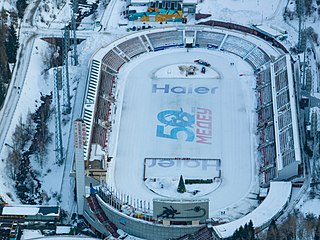
Almaty, formerly known as Alma-Ata, is the largest city in Kazakhstan, with a population of over two million. It was the capital of Kazakhstan from 1929 to 1936, while the country was an autonomous republic of the Soviet Union, then from 1936 to 1991, a union republic and finally from 1991, an independent state. In 1997, the government relocated the capital to Akmola.

The Medeu, is an outdoor speed skating and bandy rink. It is located in a mountain valley on the south-eastern outskirts of Almaty, Kazakhstan. Medeu sits 1,691 metres above sea level. It consists of 10.5 thousand square meters of ice and utilizes a sophisticated freezing and watering system to ensure the quality of the ice.

Almaty Region is a region in Kazakhstan, located in the southeastern part of the country. Its capital, from 1997 to 2022 was the city of Taldyqorğan. But with the creation of the new Jetysu Region in 2022, Taldyqorğan was chosen to be its capital and the capital of Almaty region was moved to the city of Kunayev.

The Kazakh Autonomous Socialist Soviet Republic, abbreviated as Kazak ASSR and simply Kazakhstan, was an autonomous republic of the Russian Soviet Federative Socialist Republic (RSFSR) within the Soviet Union which existed from 1920 until 1936.

The Central Stadium is a multi-purpose stadium in Almaty, Kazakhstan and the largest sports complex in the country. It is currently used mostly for football matches. The stadium is shared by FC Kairat Almaty. It also serves as the home stadium for the Kazakhstan national football team.
Orazak Ismagulov is the first and one of the only anthropologists of Kazakhstan, the doctor of historical sciences (1984) and corresponding member of the Kazakhstan National Academy of Sciences (1994).
The Central Asian Games (CAG) is an international multi-sport event organised by the Central Asian Olympic Committee (CAOC) and held every two years since 1995 among athletes from Central Asian countries and territories of the Olympic Council of Asia (OCA), especially formerly members of the Union of Soviet Socialist Republics.
Yelena Pershina is a Ukrainian-born retired female long jumper who represented Kazakhstan. Her personal best jump was 6.91 metres, achieved in August 1992 in Alma Ata.
Yuri Alexeyevich Zuev or Zuyev was a Russian-born Kazakh sinologist and turkologist.
Rugby union in Kazakhstan is a fairly popular sport. As of May 2018, they are ranked 61st by World Rugby, and as of June 2009, they had 2335 registered players and twenty clubs.
The 2003 Central Asian Games also known as the 5th Central Asian Games were held in Dushanbe, Tajikistan in 2003.
Kui is a Kipchak instrumental musical composition performed with national plucked, bow and wind instruments such as dombyra, qobyz, syrnai, mostly with the plucked dombyra of the Kazakhs and Komuz of the Kyrgyzs. In the 20th century, Kazakh Soviet musicians experimented with chorus performance of kuis.
Rustam Ukumanov is a Kazakhstani water polo player. At the 2012 Summer Olympics, he competed for the Kazakhstan men's national water polo team in the men's event. He is 6 feet 4 inches (1.93 m) tall and was born in Alma-Ata.
Ravil Manafov is a Kazakhstani water polo player. At the 2012 Summer Olympics, he competed for the Kazakhstan men's national water polo team in the men's event. He is 6 ft 4 inches tall and was born in Alma-Ata.

Yuliya Zhivitsa is a Kazakhstani sabre fencer, team bronze medallist at the 2010 Asian Games in Guangzhou, China and at the 2014 Asian Games in Incheon.
The following is a timeline of the history of the city of Almaty, Almaty Province, Kazakhstan.

Dmitriy Igorevich Balandin is a retired Kazakh breaststroke swimmer. He won the 200 m breaststroke at the 2016 Summer Olympics, as well as the 50, 100 and 200 m breaststroke events at the 2014 Asian Games.
The Kazakhstani Chess Championship is currently organized by the Kazakhstan Chess Federation. Chess was one of the sports contested at the second Kazakhstan Spartakiad held in Alma-Ata in 1933: Gubaydula Mendeshev was the winner. The first official Kazakhstani championships for men, women and juniors were held in Alma-Ata in 1934. Anatoly Ufimtsev holds the record for the most titles won with eleven.
BC SKA Alma-Ata was a former Soviet basketball club from the city of Alma-Ata. In 2013 the club has merged into BC Almaty to serve as the reserve squad in the second division Higher league under the name Almaty Legion KazNU
The 2021 Pacific-Asia Curling Championships was held from November 7 to 13 at the Almaty Arena in Almaty, Kazakhstan. The top men's team and the top two women's teams qualified for the 2022 World Men's Curling Championship and 2022 World Women's Curling Championship respectively. The next two placed teams of each gender qualified for the World Qualification Event, for a second chance to qualify for the World Curling Championships.






